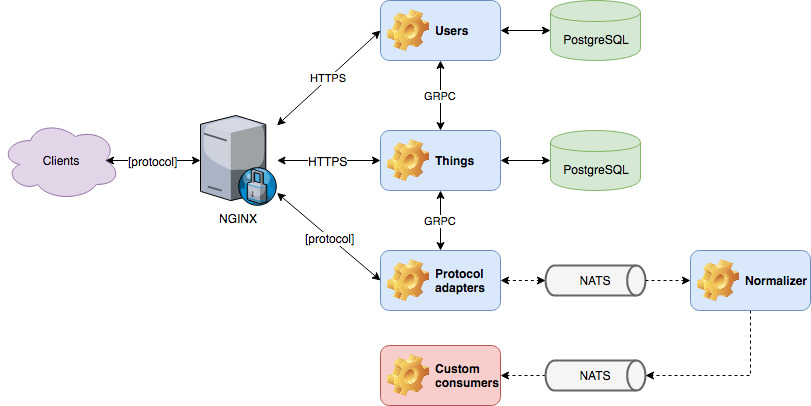* MF-488 - Remove Thing type (app or device) Signed-off-by: Manuel Imperiale <manuel.imperiale@gmail.com> * Typo fix Signed-off-by: Manuel Imperiale <manuel.imperiale@gmail.com> * Fix reviews Signed-off-by: Manuel Imperiale <manuel.imperiale@gmail.com> * Fix reviews Signed-off-by: Manuel Imperiale <manuel.imperiale@gmail.com> * Fix reviews Signed-off-by: Manuel Imperiale <manuel.imperiale@gmail.com>
2.9 KiB
Components
Mainflux IoT platform is comprised of the following services:
| Service | Description |
|---|---|
| users | Manages platform's users and auth concerns |
| things | Manages platform's things, channels and access policies |
| normalizer | Normalizes SenML messages and generates the "processed" messages stream |
| http-adapter | Provides an HTTP interface for accessing communication channels |
| ws-adapter | Provides a WebSocket interface for accessing communication channels |
| mqtt-adapter | Provides an MQTT interface for accessing communication channels |
| coap-adapter | Provides a CoAP interface for accessing communication channels |
| lora-adapter | Provides a LoRa Server forwarder for accessing communication channels |
| mainflux-cli | Command line interface |
Domain model
The platform is built around 3 main entities: users, things and channels.
User represents the real (human) user of the system. It is represented via its
e-mail and password, which he uses as platform access credentials in order to obtain
an access token. Once logged into the system, user can manage his resources (i.e.
things and channels) in CRUD fashion, and define access control policies by
connecting them.
Thing represents devices (or applications) connected to Mainflux that uses the
platform for message exchange with other "things".
Channel represents a communication channel. It serves as message topic that
can be consumed by all of the things connected to it.
Messaging
Mainflux uses NATS as its messaging backbone, due to its lightweight and performant nature. You can treat its subjects as physical representation of Mainflux channels, where subject name is constructed using channel unique identifier.
In general, there is no constrained put on content that is being exchanged through channels. However, in order to be post-processed and normalized, messages should be formatted using SenML.
